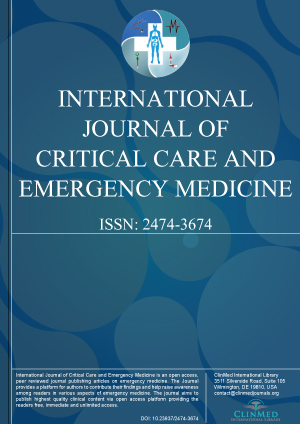Open Access DOI:10.23937/2474-3674/1510127
Use of Tranexamic Acid Prevents Intubation in ACE Inhibitor- Induced Angioedema
Ramzan Judge, Stephanie Kolaski and Farhan Qadeer
Article Type: Case Report | First Published: September 11, 2021
ACE-I, a common antihypertensive medication, regulates blood pressure by inhibiting angiotensinconverting enzyme (ACE). This inhibition prevents the formation of angiotensin II from angiotensin I, a peptide hormone that causes vasoconstriction. ACE is also involved in the degradation of bradykinin, a potent mediator of vasodilation. When ACE is inhibited, the arteriolar smooth muscle relaxes and increases blood flow, leading to increased vasodilation of blood vessels, vascular permeability, and ...
Open Access DOI:10.23937/2474-3674/1510126
COVID-19 Pneumonia: Guiding the Decision to Intubate Based on Work of Breathing Assessment Independent of Oxygenation
Amin Nadeem, Philip Fanapour, Mylene Apigo, Sunyoung Kim, Sanish George, Muhammad Khan, Azib Shahid, Charmi Patel, Ria Carnate and Raúl J Gazmuri
Article Type: Original Article | First Published: August 04, 2021
In most patients, COVID-19 pneumonia initially causes significant hypoxemia but without substantial impairment of lung compliance that would increase the work of breathing (WOB). Once adequate oxygenation is established, a tool to determine WOB independent of oxygen needs can guide the decision to intubate for invasive mechanical ventilation (IMV). We monitored oxygen requirements and WOB in 10 patients admitted with severe COVID-19 pneumonia (radiographic evidence of extensive lung disease with...
Open Access DOI:10.23937/2474-3674/1510125
Knowledge, Attitude and Practices of ICU Nurses on Catheter Related Bloodstream Infection (CRBSI)
Nur Aimi Safura Binti Azlan and Khin Thandar Aung
Article Type: Original Article | First Published: July 23, 2021
Bloodstream infections (BSIs) are associated with insertion and maintenance of central venous catheters (CVC). Catheter Related Bloodstream Infection (CRBSI) is the most frequent causes of healthcare-associated infections in intensive care units (ICUs) and is a major challenge for health care providers working in intensive care units. It gives the higher risk to the mortality rate of ICU patients and also increased length of ICU stay and additional healthcare costs for them. Most international i...
Open Access DOI:10.23937/2474-3674/1510124
Continuous Lower Abdominal Compression a Possible Therapeutic Intervention in ARDS
Alexandru Cupaciu, MD, Vladimir Cohen, MD, Emmanuel Dudoignon, MD and François Dépret, MD, PhD
Article Type: Editorial | First Published: June 30, 2021
We report the case of sixty-years-old men who necessitated intubation and mechanical ventilation for severe COVID-19. After 3 days under mechanical ventilation, in semi recumbent position, despite being ventilated with 5.5 ml/kg/IBW and 8 cmH2O of positive end expiratory pressure (PEEP), deeply sedated and paralyzed, his plateau pressure (Pplat) was markedly elevated at 41 cmH2O. However, we noticed that placing our patient in supine position his Pplat decreased to 28 cmH2O. However, due to well...
Open Access DOI:10.23937/2474-3674/1510123
Intra-aortic Balloon Pump Induced Dynamic Left Ventricular Outflow Tract Obstruction and Cardiogenic Shock: A Case Report
Shiun Woei WONG, MRCP and Ke Xuan Jessica Ng, MRCP
Article Type: Case Report | First Published: July 10, 2021
We present a complex case of a 50-year-old man who presented with inferior ST-elevation myocardial infarction and cardiogenic shock. Our patient presented with out-of-hospital ventricular fibrillation cardiac arrest. Cardiopulmonary resuscitation was promptly started and return of spontaneous circulation was achieved. The patient underwent urgent coronary angiography with implantation of drug-eluting stent in his right coronary artery. Intra-aortic balloon pump was inserted. However, this was co...

